Churches in Nice
Old Nice has 10 churches in about a square mile, and from the most opulent to the most obscure, each has its own quirks and story. Here’s what’s behind all that stained glass… with an interactive map.
But first, here is a link to my schedule of classical concerts held in Nice’s Baroque churches, and a link to the current mass schedule. The larger churches are open daily for visits, but most of the smaller or more obscure churches in Nice are open to the public on Tuesday afternoons.
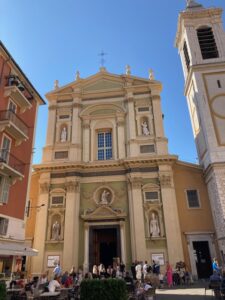
Cathedrale Sainte-Reparate, the oldest and most ornate church in the city, has been in existence since the 1200’s; it was rebuilt and made a Cathedral, and has been the Catholic heart of the city for 400 years. It’s named after a pious Palestinian teen, Reparate, who was arrested for her Christian faith in the year 1060, but refused to renounce. Her torturers tried their worst, but nothing could convince her to abandon her faith, and as each of their execution attempts were foiled by angels… Burn her at the stake? Sudden downpour. Drink poison? Cast iron stomach.
Finally they went with the foolproof method and just beheaded her. As was the custom after such executions, in order to deny her a Christian burial, her body was put out to sea on a raft to rot and be desecrated by sea birds …but once again the angels took over and guided her raft across the Mediterranean sea to the bay of Nice, where her body arrived pristine and untouched, and it was declared a miracle. That is how the bay of Nice became named the Bay of Angels and how the young martyr became Saint-Reparate, the patron saint of the Cathedral in Old Nice, and you can see all this depicted in her dedicated interior chapel, the second on the left as you enter. Located at Place Rossetti in Old Nice, tram stop Cathédrale; open for visits daily but closed for lunch between 12-2pm.
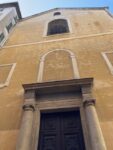
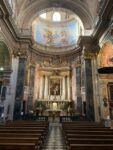 Eglise Sainte-Rita The local’s favorite, it has the most unassuming entrance but inside is one of the most beautiful (or kitschy, depending on whom you ask), with its rosy glow, crystal chandeliers, and pink marble everywhere. Rita deserves a pretty church: she is the patron saint of lost causes …which is a really tough gig! 1 Rue de la Poissonnerie, just off Cours Saleya. Open daily but closed for lunch.
Eglise Sainte-Rita The local’s favorite, it has the most unassuming entrance but inside is one of the most beautiful (or kitschy, depending on whom you ask), with its rosy glow, crystal chandeliers, and pink marble everywhere. Rita deserves a pretty church: she is the patron saint of lost causes …which is a really tough gig! 1 Rue de la Poissonnerie, just off Cours Saleya. Open daily but closed for lunch.
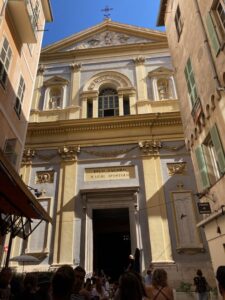 The magnificent Eglise du Gesu is the most baroque, and looks out on the most auspicious intersection of the former Street of the Jews (where the city’s Jews used to be locked in at night; now rue Benoit Bunico), and Jesus Street (Gesu is Jesus in the Nissart language). It boasts a wonderful peculiarity… in the far left corner is the doorway to the church’s own bar, called Le Bethel, tucked in a hidden interior patio. For summer 2025 it is open for coffee or brunch on Saturday and Sunday mornings; and a packed bar scene on Saturday nights from 6:30pm to 11pm. It’s the initiative of Father Frederic, who would like to reach out to an new generation and encourage people to stay awhile, not see the church and rush right out. 1 Rue du Jésus, on rue Droite just off Cours Saleya. Open daily but closed for lunch between 12-2pm, and often stays open until midnight during the summer.
The magnificent Eglise du Gesu is the most baroque, and looks out on the most auspicious intersection of the former Street of the Jews (where the city’s Jews used to be locked in at night; now rue Benoit Bunico), and Jesus Street (Gesu is Jesus in the Nissart language). It boasts a wonderful peculiarity… in the far left corner is the doorway to the church’s own bar, called Le Bethel, tucked in a hidden interior patio. For summer 2025 it is open for coffee or brunch on Saturday and Sunday mornings; and a packed bar scene on Saturday nights from 6:30pm to 11pm. It’s the initiative of Father Frederic, who would like to reach out to an new generation and encourage people to stay awhile, not see the church and rush right out. 1 Rue du Jésus, on rue Droite just off Cours Saleya. Open daily but closed for lunch between 12-2pm, and often stays open until midnight during the summer.
 The luminous yellow Misericord Chapel (which means ‘mercy’) is right in the middle of Cours Saleya, and is noted for its unusual circular walls and windows. As luminous as this church is, it had a very somber mission: starting in 1329 after the Cholera epidemic, its role was to arrange pauper’s burials as well as to minster to prisoners condemned to death. Open for visits Tuesday afternoons.
The luminous yellow Misericord Chapel (which means ‘mercy’) is right in the middle of Cours Saleya, and is noted for its unusual circular walls and windows. As luminous as this church is, it had a very somber mission: starting in 1329 after the Cholera epidemic, its role was to arrange pauper’s burials as well as to minster to prisoners condemned to death. Open for visits Tuesday afternoons.
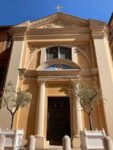 At the top of Cours Saleya, the Saint Suaire Chapel held the famous Shroud of Turin (Saint Suaire in French), the burial cloth said to bear the imprint of Jesus Christ, before it was moved permanently to Turin. Currently, this little church holds a Latin mass every Sunday, sometimes with Gregorian chants, and is open for visits Tuesdays from 10-noon and 2-5pm. There is a little museum in the Cimiez Monastery that has a really great display on the Shroud of Turin, and it’s free.
At the top of Cours Saleya, the Saint Suaire Chapel held the famous Shroud of Turin (Saint Suaire in French), the burial cloth said to bear the imprint of Jesus Christ, before it was moved permanently to Turin. Currently, this little church holds a Latin mass every Sunday, sometimes with Gregorian chants, and is open for visits Tuesdays from 10-noon and 2-5pm. There is a little museum in the Cimiez Monastery that has a really great display on the Shroud of Turin, and it’s free.
The story of the Penitents. In the beginning of Christianity, after confessing a very grave sin, the sinner might be assigned a penance that was to be carried out over a period of time, which might be to self-punish, do works like repairing a church, or help the poor and sick. The penitents wore special colored robes to denote their low status while doing this work to purge their sins. In the 4th century, there were those that entered the order of Penitents voluntarily, which was essentially entering into a monastic life of privation, service and prayer. Old Nice has 4 penitent churches, each of which had a different mission and dress, including a specific hairstyle, accessories, and most important, robe color.
- Whites: The earliest order of Penitents in Nice were formed in 1306, and were based at the Chapel Sainte-Croix (up rue de la Loge, 1 place Saint Joseph in Old Nice, visits Tuesday afternoons 2;30-5pm). The White Penitents started with small 11-bed hospital for the poor on nearby rue Zanin, where they would accept anyone that was sick… except those that were crazy, contagious (for security reasons), incurables (because they would uselessly take up a bed), or prostitutes (because their sickness was seen, rather judgmentally I might add, to be their own fault). Eventually their hospital grew and they needed reinforcements, so they invited in the Order of the Humiliated Sisters, aka the Grey Penitents.
- Blacks: The Black Penitents were formed in 1329 after the Cholera epidemic swept through Nice, and it fell to the appropriately attired Blacks to hold pauper’s burials and deal with prisoners condemned to the death penalty. For such a somber focus, it’s surprising to discover that their home was the aforementioned sunny yellow Chapel de la Misericord in the middle of Cours Saleya.
- Reds: the focus of the Red Penitents were abandoned children, and they ran an orphanage out of their Saint Suaire Chapel, the tiny chapel at the very top of Cours Saleya, mentioned above. The chapel that got its name from when it hid the Shroud of Turin, or Saint Suaire, for 5 years in the 16th century to protect it from invaders.
- Blues: The mission of the Blue Penitents was to tend to the lepers, but once leprosy was less of a problem, they turned the leper hospital into a orphanage for abandoned girls. Their Chapel of Saint Sépulcre is an easy one to miss: the door is hidden in the middle of restaurant row on the south side of Place Garibaldi, and the actual church is a surprise to discover on the second floor. Open for visits on Tuesdays from 2:30-5pm.
For more on the monastic life in Nice in the middle ages, stop by the free Franciscan Friar Museum tucked into the Cimiez Monastery, mentioned below, with link.
 From the Garibaldi Chapel of Saint Sepulcre, continue just past the Garibaldi-Le Chateau tram stop, and head up rue Sincaire for 2 minutes to see the Saint Augustin baroque church, where Martin Luther held a mass in 1510. Just across from the church is a massive bas relief carved into stone of the Nicoise heroine washerwoman that saved Nice in 1543.
From the Garibaldi Chapel of Saint Sepulcre, continue just past the Garibaldi-Le Chateau tram stop, and head up rue Sincaire for 2 minutes to see the Saint Augustin baroque church, where Martin Luther held a mass in 1510. Just across from the church is a massive bas relief carved into stone of the Nicoise heroine washerwoman that saved Nice in 1543.
Continue down that street to find the Chapel of the Visitation which is now the cultural center La Providence. It was originally the chapel associated with the convent at rue Saint Francois, but in the early 1800’s it had fallen into disrepair and became an orphanage “The Girls of Providence”, funded by loaning the girls out to conspicuously cry at funerals. Now a thriving culture and arts center, La Providence is open for visits most weekdays, except during lunch. Check out the posters for upcoming concerts/exhibitions/events.
Notable Churches Outside of the Old Town
Just outside the Old Town, across the the Promenade du Paillon gardens and fronted by a beautiful little orange grove, is the Church of the Vow. In 1832, Cholera had decimated the Var and was making its way toward Nice. The town council put emergency sanitation measures in place, but just to be on the safe side, voted a municipal order placing Nice under the protection of the Virgin Mary and making a solemn vow: if the town was spared, it promised to build a new church dedicated to the Madonna and do a yearly procession and religious celebration in her honor. Both sides did indeed keep their bargain, and every spring the statue of Mary is dutifully carried in a possession from the Church of the Vow all through the Old Town. Open daily, 9am-7pm.
On Cimiez, on the site of the ancient Roman city, you walk through a 2000-year-old olive grove to arrive at the ancient (but still working) Franciscan Monastery with a stately church, and magnificent Italian-style gardens, tended by the monks. The church and gardens are open daily, while the monastery is not… however you can visit the tiny Friar’s museum on the third floor, which is a fascinating look into the life of a monk, and has an especially interesting room dedicated to the Shroud of Turin (Saint Suaire in French), the burial cloth that may-or-may-not show the imprint of Christ’s body, which was held in Nice for a time in the 14th century. Behind the Monastery you’ll come upon a cemetery, where you can find Matisse’s strikingly sober tomb as well as that of artist Raoul Dufy. Get there with Bus #5. Open daily.
The neo-Gothic Notre-Dame Basilica on boulevard Jean-Médecin looks non-coincidentally like a mini-version of the famous Notre Dame Cathedral in Paris, but sans the hunchback and gargoyles. In 2020 it was the site of a early morning attack by a sword-brandishing Islamic extremist that took the lives of 2 parishioners and the caretaker. The 21-year-old Tunisian terrorist was caught and is in prison for life. The largest church in Nice, the Notre-Dame Basilica is a major classical concert hub. Open daily 9:30am-noon and 4pm-7pm. Tram stop Jean Médecin.
Another home of classical concerts, and with a very similar name, Notre-Dame-du-Port is like a baroque jewel crowning the Nice Port, at 8 place d’Ile de Beaute (tram stop Port Lympia). Open every day except for Sunday, 8am-7pm. Besides keeping an eye on the fishing boats, this church hosts free Sunday afternoon orchestra concerts at 3:30pm all during the winter, alternating with the Notre-Dame Basilica, above. (In the summer these concerts happen in the seaside gazebo on the Promenade du Paillon gardens or on Cimiez.)
Nice even has a jazz musician priest, the flamboyant Father Gil Florini, whos unconventional masses at the Eglise Saint-Pierre-de-l’Arene at 52 Rue de la Buffa are legendary, including the rollicking musical Messe des Artistes on Ash Wednesday, the animal’s mass where you can bring your pets and get them blessed, and even an annual mass to bless cellphones and tablets the end of September. The energetic priest turned the church crypt into a restaurant that is open to the public but also serves free to the homeless, and Father Florini is also the father of Pastis de Nice, where he has been brewing his signature pastis in his distillery (and gift shop, 3 Rue de Orestis) in the Port district.
 Speaking of flamboyant, the Saint Nicolas Russian Orthodox Cathedral is kind of a shock, with its boldly colored turrets and dramatic minarets that seem entirely out of place. It is dedicated to the brilliant and beloved heir-apparent to Imperial Russia who died in Nice of Spinal Meningitis at the age of just 21 years old. The villa where he died was ordered demolished by his distraught parents, and this Cathedral was built on the exact spot where he died. More recently, after a lengthy legal battle with France, the Cathedral is now owned and run by …the Kremlin! Tram stop Alsace-Lorraine then a 10-minute walk to Avenue Nicolas II. Open 10am-1pm and 2-6pm Monday-Saturday, and afternoon hours only on Sunday.
Speaking of flamboyant, the Saint Nicolas Russian Orthodox Cathedral is kind of a shock, with its boldly colored turrets and dramatic minarets that seem entirely out of place. It is dedicated to the brilliant and beloved heir-apparent to Imperial Russia who died in Nice of Spinal Meningitis at the age of just 21 years old. The villa where he died was ordered demolished by his distraught parents, and this Cathedral was built on the exact spot where he died. More recently, after a lengthy legal battle with France, the Cathedral is now owned and run by …the Kremlin! Tram stop Alsace-Lorraine then a 10-minute walk to Avenue Nicolas II. Open 10am-1pm and 2-6pm Monday-Saturday, and afternoon hours only on Sunday.
This isn’t even an exhaustive list! I haven’t even mentioned the Church of Saint-Francois-de-Paul across from the Nice Opera, the Holy Trinity Anglican Church on 11 rue de la Buffa, the all white Eglise Jeanne d’Arc at 11 rue de Grammont (tram stop Borriglione), or the Greek Orthodox Church just off Boulevard Carabacel.
The main Synagogue is just behind Galeries Lafayette, with a sober limestone façade, and unfortunately, due to a spate of shameful anti-Semitic acts around France, has a 24-hour military guard. Tram stop Massena.
There is currently only one Mosque in Nice on the outskirts of town, but that doesn’t stop the faithful from meeting in a makeshift prayer room on rue de Suisse, and sometimes spilling out onto the sidewalks on the side of the Notre-Dame Cathedral (to the great displeasure of certain right-wing organizations…) A target for right-wing antics, you will find the Mosque El Nour at 1 avenue Pontremoli, tram stop La Plaine.
Farther outside of Nice, I would recommend the Matisse Chapel in Vence, which he designed down to the smallest detail and considered the culmination of his life’s work, the tiny Jean Cocteau fishermen’s chapel in Villefranche-sur-mer, and the Cathédrale in Monaco where Princess Grace was married, and ultimately buried.
- Back up to main What to See in Nice page
Photo Credits: Russian Cathedral from Living on the Cote d’Azur.com, all others Best of Nice.
